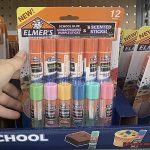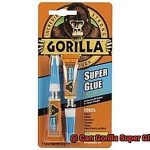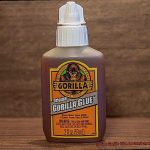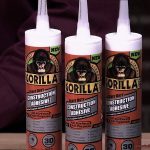Have you ever been in a bind where you needed to stick something together, but didn’t have the right adhesive on hand? It’s a frustrating feeling, isn’t it? And if you’ve ever used Gorilla Glue before, you might have wondered whether it could be used as an epoxy substitute.
Gorilla Glue and epoxy are both popular choices for bonding materials. However, they differ in their adhesive properties. Gorilla Glue is a polyurethane-based adhesive that expands as it dries and bonds to almost anything – metal, wood, ceramics and more. Epoxy, on the other hand, is a two-part adhesive that hardens into a strong, durable and waterproof bond that can withstand high levels of stress and strain.
So can Gorilla Glue be used as an epoxy? The answer is both yes and no. While Gorilla Glue can be used as a temporary fix or when the surface area is small, it’s not an exact replacement for epoxy. For larger projects or those requiring specialized adhesives, it’s recommended to use proper epoxy adhesive.
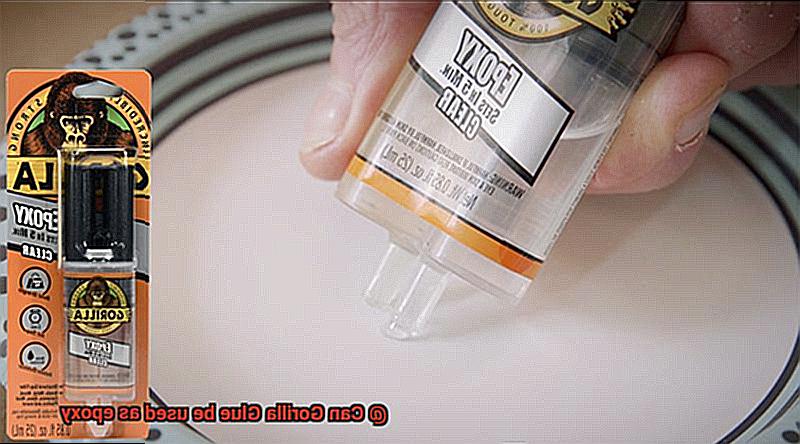
But don’t worry – we’re here to help. In this blog post, we’ll explore the similarities and differences between Gorilla Glue and epoxy. We’ll also explain how to use Gorilla Glue as an alternative to epoxy and discuss its limitations. So if you’re curious about whether Gorilla Glue can be used as epoxy or just want to learn more about these adhesives in general – keep reading.
What is Gorilla Glue?
Contents
- 1 What is Gorilla Glue?
- 2 What is Epoxy?
- 3 The Similarities between Gorilla Glue and Epoxy
- 4 The Differences between Gorilla Glue and Epoxy
- 5 When Should You Use Gorilla Glue Instead of Epoxy?
- 6 How to Use Gorilla Glue as an Epoxy Substitute
- 7 Pros and Cons of Using Gorilla Glue as an Epoxy Substitute
- 8 Conclusion
Are you tired of struggling with weak adhesives that can’t hold up to your DIY projects? Look no further than Gorilla Glue, the polyurethane-based adhesive that has taken the industry by storm since its introduction in 1999.
What sets Gorilla Glue apart is its unique moisture-activated curing process, which creates an incredibly strong bond. The glue is made from polyurethane, a polymer that is found in many products like mattresses, insulation, and car parts.
This powerful formula can bond to almost anything, including wood, metal, ceramic, stone, and much more. Its waterproof nature and ability to withstand extreme temperatures make it ideal for both indoor and outdoor use.
While Gorilla Glue shares some characteristics with epoxy, it’s important to note that they are not interchangeable. Epoxy requires mixing and has a longer curing time than Gorilla Glue. However, in some cases, Gorilla Glue can be used as a substitute for epoxy depending on the project’s specific requirements.
When it comes to versatility, Gorilla Glue is unmatched. It’s perfect for repairing furniture, fixing metal fixtures or ceramic tiles, or even creating sculptures out of stone. Its versatility and strength make it a favorite of professionals and DIYers alike.
But before you start applying Gorilla Glue to everything in sight, it’s important to remember that not all materials will respond well to this adhesive. In certain situations, such as those involving high heat or constant exposure to water, epoxy may be a more suitable choice.
What is Epoxy?
This thermosetting polymer is a two-part adhesive that consists of a resin and a hardener. When these two components are combined, they create a chemical reaction that results in a strong, durable, and waterproof bond.
Epoxy is a versatile adhesive that can be used on an array of surfaces such as metal, wood, concrete, and plastic. This makes it a popular choice for construction projects where different materials need to be bonded together. Its strength and durability make it an excellent choice for coatings, paints, and sealants as well.
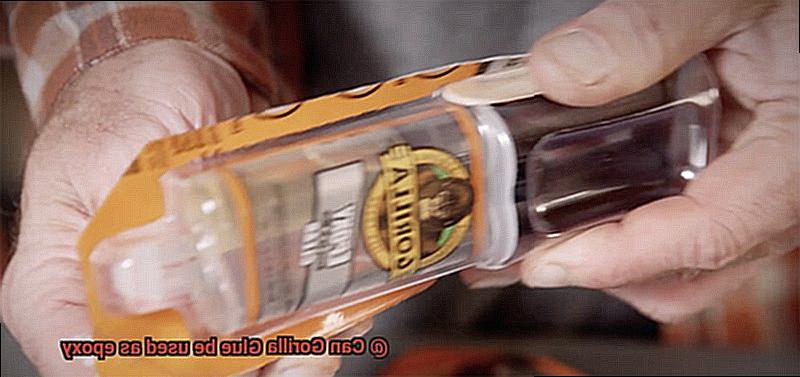
One of the best features of epoxy is its resistance to chemicals, heat, and moisture. This means that it can withstand harsh conditions and protect surfaces from damage. Whether you need to waterproof your basement or protect your garage floor from chemical spills, epoxy has got you covered.
However, it’s important to note that epoxy has a limited working time. This means that once the resin and hardener are mixed together, you need to work quickly and efficiently to apply the adhesive before it starts to set. Following the manufacturer’s instructions is crucial to achieving the desired results.
The Similarities between Gorilla Glue and Epoxy
First and foremost, both Gorilla Glue and epoxy are renowned for their high strength and versatility. They can bond an array of materials, from wood to metal, plastic to ceramics. Whether you’re working on a woodworking project or fixing a broken car part, both adhesives can provide a robust and long-lasting bond.
Another key similarity between these two adhesives is their ability to fill gaps and cracks. This feature is especially useful when bonding uneven or irregular surfaces. Gorilla Glue expands as it dries, allowing it to fill gaps and create a tight seal between surfaces. Epoxy has a thick consistency that enables it to fill gaps and produce a smooth finish.
What’s more, both Gorilla Glue and epoxy have a lengthy curing time, requiring time to set and dry entirely for maximum strength. Gorilla Glue takes around 24 hours to cure completely, while epoxy can take up to 48 hours depending on temperature and humidity.
Lastly, both adhesives are waterproof and resistant to heat and chemicals. They can withstand extreme temperatures and are impervious to water, oil, and various other chemicals. This makes them ideal for outdoor or marine applications where exposure to moisture or harsh conditions is common.
The Differences between Gorilla Glue and Epoxy
As an expert in the field, I’ve dug deep to unearth several key differences between these two popular adhesives. Let’s dive in and explore their unique properties.
Composition is the first point of distinction between Gorilla Glue and epoxy. Gorilla Glue is a polyurethane-based adhesive, while epoxy is a two-part adhesive composed of resin and hardener. This difference in composition leads to variations in their working properties. Gorilla Glue expands as it cures, which makes it difficult to use in precise applications. Epoxy, on the other hand, has a more controlled curing process, making it easier to use in precise applications.
Drying time is another significant difference between the two adhesives. Gorilla Glue typically dries within 24 hours, while epoxy can take several hours to cure fully. This makes Gorilla Glue a better option for quick repairs or projects that require immediate use.
Strength is a crucial factor when selecting an adhesive. Both Gorilla Glue and epoxy are known for their robust bonding capabilities, but epoxy tends to be stronger and more durable in the long run. It can withstand higher temperatures, chemicals, and moisture better than Gorilla Glue.
Application method is a final point of divergence between Gorilla Glue and epoxy. Gorilla Glue is generally applied directly to the surfaces being bonded together, while epoxy requires mixing of the resin and hardener before application.
In summary, both Gorilla Glue and epoxy have their own unique strengths and weaknesses. While Gorilla Glue may be a suitable substitute for epoxy in some cases, it’s essential to consider the differences between the two adhesives before making a decision. Factors such as drying time, strength, and application method should all be taken into account when choosing between Gorilla Glue and epoxy for a particular project.
When Should You Use Gorilla Glue Instead of Epoxy?
To begin with, let’s delve into the properties of Gorilla Glue. This polyurethane-based adhesive is perfect for filling gaps and cracks in surfaces and has a longer working time than epoxy, allowing you more time to adjust the pieces before the glue sets. It is also water-resistant and can be painted over once dry.
On the other hand, epoxy is a two-part adhesive that consists of a resin and a hardener. When mixed together, they create a strong, durable bond that can withstand heavy loads and extreme temperatures. Epoxy is ideal for bonding non-porous materials such as metal, glass, and ceramic, as well as for filling large gaps or cracks.
So, when is it appropriate to use Gorilla Glue instead of epoxy? Let’s take a look at some factors to consider:
- Porous Materials: If you’re working with porous materials like wood or fabric, Gorilla Glue may be your best bet due to its ability to expand as it dries.
- Filling Gaps and Cracks: If your project requires filling gaps or cracks, Gorilla Glue’s expansive properties make it an excellent choice.
- Different Expansion Rates: If you need to bond materials that have varying expansion rates, Gorilla Glue is an ideal option.
- Longer Working Time: If you require a longer working time to adjust your pieces before the glue sets, Gorilla Glue is the way to go.
On the flip side, if you’re working with non-porous materials such as metal or glass or require an adhesive that can withstand high temperatures or heavy loads, epoxy is likely the better choice. Epoxy is also great for projects that require a clear finish or filling larger gaps or cracks.
In summary, selecting between Gorilla Glue and epoxy depends on the specific needs of your project. It is essential to consider the materials you’re working with, the size of any gaps or cracks you need to fill, and the conditions your project will be exposed to. By doing so, you’ll be able to select the appropriate adhesive for your project and guarantee a strong, durable bond.
How to Use Gorilla Glue as an Epoxy Substitute
Gorilla Glue, a polyurethane adhesive known for its strength and versatility, can be used as an epoxy substitute in certain cases. While it may not have the same properties as epoxy, it can still be a handy solution when you don’t have epoxy on hand.
Here are some information explaining how to use Gorilla Glue as an epoxy substitute:
Surface Preparation
Before applying Gorilla Glue, ensure that the surfaces you want to bond are clean and dry. Gorilla Glue works best on porous surfaces, so if you’re bonding non-porous materials like metal or plastic, you may need to roughen the surface with sandpaper to create a better bond.
Application
Apply a small amount of Gorilla Glue to one surface. Remember that the glue expands as it dries, so only apply a little to avoid making a mess. Press the two surfaces together firmly and hold them in place until the glue dries. You should clamp them if necessary.
Drying Time
The drying time for Gorilla Glue depends on the humidity and temperature, but it typically takes 1-2 hours to set and 24 hours to fully cure. It’s important to note that Gorilla Glue sets through a process of moisture activation, meaning it needs moisture to cure properly. This makes it a good option for use on surfaces that may be difficult to dry, such as wood or concrete.
Limitations
While Gorilla Glue can be used as an epoxy substitute in some cases, it may not be suitable for all applications. For example, it may not be able to withstand high temperatures or heavy loads. Also, because it expands as it cures, it may not be ideal for use on small or delicate objects.
Post-Application
Once the glue has dried completely, any excess glue can be sanded or trimmed away. It’s important to note that Gorilla Glue is not ideal for all epoxy applications. While it can be used as a substitute for some applications, it does not have the same properties as epoxy. Epoxy is typically more heat-resistant and has a higher shear strength than Gorilla Glue.
Pros and Cons of Using Gorilla Glue as an Epoxy Substitute
Gorilla Glue may seem like a viable option, but before jumping in, there are both advantages and disadvantages to consider.
Firstly, one of the biggest pros of using Gorilla Glue as an epoxy substitute is its strength. This adhesive is incredibly powerful and can bond materials together with great effectiveness. Additionally, it’s waterproof and weather-resistant, making it perfect for outdoor projects.
Another benefit of using Gorilla Glue as an epoxy substitute is its versatility. Unlike many epoxies that require mixing, Gorilla Glue can be used straight out of the bottle. It can also be used on a variety of surfaces such as wood, metal, and plastic.
However, there are some downsides to keep in mind. One major drawback is the extended drying time required by Gorilla Glue. This can be frustrating if you need to finish a project quickly.
Another con is its expansion when it dries. Gorilla Glue expands as it cures, which can cause issues if you’re working with delicate materials or require a precise fit. Additionally, cleaning up Gorilla Glue can be difficult if you accidentally get it on your skin or clothing.
tU5bCl8WMoc” >
Also Read: Does Gorilla Glue Work on Plastic?
Conclusion
In conclusion, it’s important to recognize that while Gorilla Glue and epoxy may seem interchangeable at first glance, they each have their own distinct characteristics that set them apart. Gorilla Glue’s polyurethane-based formula makes it a versatile adhesive that can bond almost anything and fill gaps and cracks effectively. However, its strength pales in comparison to epoxy, which boasts a two-part resin and hardener formula that creates a stronger, more durable bond capable of withstanding high levels of stress and strain.
While Gorilla Glue can be used as an alternative to epoxy in certain situations – such as when working with porous surfaces or filling small gaps and cracks – it may not be suitable for all applications. It’s essential to consider factors such as the materials being bonded, the size of gaps or cracks, and the conditions the project will be exposed to when selecting an adhesive.
Ultimately, both Gorilla Glue and epoxy have their unique strengths and weaknesses. By understanding these differences, you can make an informed decision about which adhesive is best suited for your specific project needs.
So, whether you’re repairing a broken vase or constructing a new piece of furniture from scratch, take the time to carefully evaluate your options before making a final choice.


